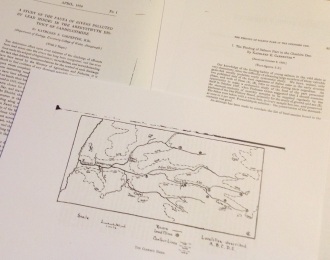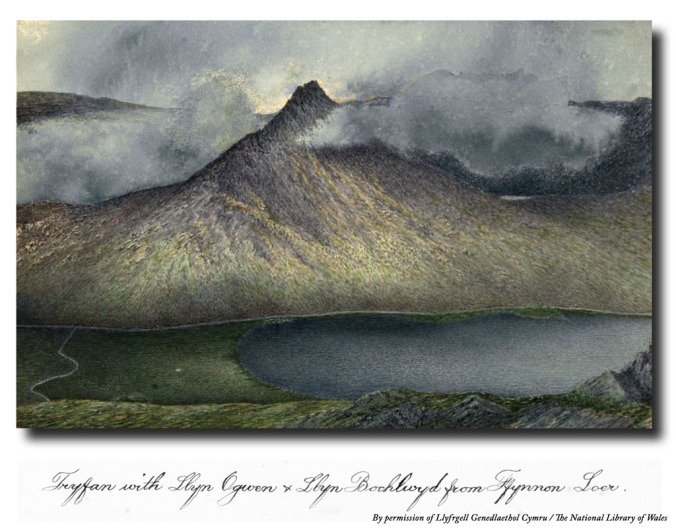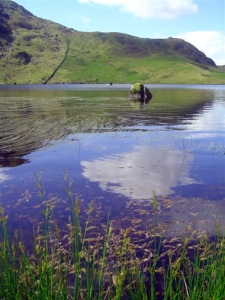Every year Bangor University students visit Cwm Idwal to see and discuss the conservation importance of the lake as part of an undergraduate module on freshwater ecosystems. Last year we decided to set a new science communication challenge for the students by asking them to write a blog on the experience. Christopher Stuart Forrest produced an outstanding article which we are delighted to be able to publish here. In addition this exercise was described by external course examiners as ‘exemplar’ giving students the chance to combine science and the arts.
We look forward to bringing more students to walk in the footsteps of Charles Darwin at Cwm Idwal. It is evident from this blog that a visit to this site in any weather can be an inspirational experience.
Catherine Duigan & Nathalie Fenner

Llyn Idwal under a cloud roof. Photo by Warren Kovach.
Standing above Llyn Idwal this weekend past, I found myself wishing I could simply rest and watch this upland landscape play through thousands of years in a matter of months, to watch the snow fall and the steam rise above Twll Du, Devil’s Kitchen. Nowhere else have I found a place which provokes such a visceral feeling of wilderness, of the Old World. I hope my words can portray the pictures of Cwm Idwal as it passes through the seasons.
In the depths of winter, a primeval scene is set. The frozen llyn, with the ice insulating life below, shifts focus to the apparently bare geology of this amphitheatre. I am reminded of volcanism; of the time through which the landforms have taken shape to what is now the Idwal Syncline (Fitches and Scott, 1992); of the Welsh derived names known globally for describing the significant periods of formation and deformation: Cambrian, Ordovician and Silurian (Fitches and Scott, 1992; Gradstein et al., 2004; Murchison, 1839; Sedgwick and Murchison, 1835; Ratcliffe, 1977). I am reminded of the significance the geology this site holds for the llyn; the acid-buffering qualities of the bare alkaline rock of its shallow basins (Duigan et al., 1998; Rimes, 1992), having helped to stabilise the water chemistry over the past 100 years in the face of agriculture and industry (Fritz et al., 1991; Rimes, 1992). I am reminded that the geology I now present to you was once the study of Darwin; a geology which informed the world (Darwin, 1842). With annual flowers absent and animal activity reduced, the cwm seems paused, awaiting revival.
In the warmth of spring, the long melted ice reveals the clear, nutrient poor waters of the llyn, the corrie lake, as a window to the past. The prehistoric fern, the pillwort (Pilularia globulifera); the water horsetail (Equisetum fluvitaile); and the watermilfoil (Myriophyllum alterniflorum) emerge to set an ancient scene. Engineering the environment are the mostly perennial isoetid communities, an incredibly significant part of such a freshwater system (Murphy, 2002). Of these, the quillwort (Isoetes lacustris) dominates (Duigan et al., 1998), and has been present at Llyn Idwal for many thousands of years (Godwin, 1955). It is joined by the rare flowering water lobelia (Lobelia dortmanna); the herbaceous shoreweed (Littorella uniflora); and the annual awlwort (Subularia aquatica). With their rosette forms and blends of green and yellow leaves carpeting the llyn, the isoetids tolerate the conditions of this soft-water like no other plant species could (Roelofs, 2002). Indeed, it is under this stress that they thrive (Murphy, 2002; Szmeja, 1987). Their interactions with their immediate environment, which includes the ability to harvest carbon dioxide from the sediment, respire through the night and readily acquire available nitrates, allow them not just to survive but to maintain the balance of the llyn’s chemistry (Madsen et al., 2002; Roelofs, 2002; Smolders et al., 2002). One might notice the presence of the floating bulbous rush (Juncus bulbosus var. fluitans), which, though not an isoetid, can too survive through acquiring carbon dioxide through sediment (Wetzel et al., 1985). The conditions created and maintained by the rocks, the isoetids and the rainwaterfeeding the llyn (Roelofs, 2002) facilitate the survival of an old rare algal species, the stoneworts (Nitella gracilis and N. opaca). In a lake of different chemistry, they might simply perish (Gomes and Asaeda, 2009).
There is rarity in Cwm Idwal, and a greater number of species than I have cared to mention above; it is incredibly rich in species in the llyn alone (Ratcliffe, 1977). I do not view its conservation value in scarcity or rarity, however, but in the value placed upon the attributes I have discussed. I find myself paraphrasing UNESCO in my justification of why Cwm Idwal is so important. It embellishes Welsh culture and heritage in its geological history; it is forever entwined in global academic development of geological science due in no small part to the ideas of Darwin; its natural beauty is unquestionable; and its plants maintain a representation of Earth’s past, in a significant geological setting (UNESCO, 2005).I hope that I will not be writing again in ten years’ time appealing for protection of the characteristic species, having then become rare.
References
Darwin, C. (1842). Notes on the Effects Produced by the Ancient Glaciers of Caernarvonshire, and on the Boulders Transported by Floating Ice, Philosophical Magazine, 21, 180 – 188.
Duigan, C. A., Allott, T. E. H., Monteith, D. T., Patrick, S. T., Lancaster, J.and Seda, J. M. (1998). The Ecology and Conservation of LlynIdwal and LlynCwellyn (Snowdonia National Park, North Wales, UK) – Two Lakes Proposed as Special Areas of Conservation in Europe, Aquatic Conservation: Mar. Freshw. Ecosyst.,8, 325 – 360.
Fitches, W. R. and Scott, R. (1992). ‘Wales’, in Treagus, J. E. (Ed.) Caledonian Structures in Britain: South of the Midland Valley, London, Chapman & Hall, pp. 98 – 116.
Fritz, S. C., Kreiser, A. M., Patrick, S. T. and Battarbee, R. W. (1991). ‘The Causes and History of Acidification in North Wales – Evidence from Lake Sediments’, in Gritten, R. H. (Ed.), Proceedings of Acid Deposition in Gwynedd Conference, Plas Tan-Y-Bwlch, Maentwrog, 16 – 18 March, 1989, Snowdonia National Park Authority, pp. 69 – 75.
Godwin, H. (1955). Vegetational History at Cwm Idwal: A Welsh Plant Refuge, SvenskBotaniskTidskrift, 49, 35 – 43.
Gomes, P. I. A. and Asaeda, T. (2009). Phycoremediation of Chromium (VI) by Nitella and Impact of Calcium Encrustation, Journal of Hazardous Materials, 166, 1332 – 1338.
Gradstein, F. M., Ogg, J. G. and Smith, A. G. (2004). A Geologic Time Scale, Cambridge, Cambridge University Press.
Madsen, T. V., Olesen, B. and Bagger, J. (2002). Carbon Acquisition and Carbon Dynamics by Aquatic Isoetids, Aquatic Botany, 4 (4), 351 – 371.
Murchison, R. I. (1839). The Silurian System Founded on Geological Researches in the Counties of Salop, Hereford, Radnor, Montgomery, Caermarthen, Brecon, Pembroke, Monmouth, Gloucester, Worcester, and Stafford: with Descriptions of the Coal-fields, and Overlying Formations, Vol. 1 & 2, London, John Murray.
Murphy, K. J. (2002). Plant Communities and Plant Diversity in Softwater Lakes of Northern Europe, Aquatic Botany, 4 (4), 287 – 324.
Ratcliffe, D. A. (1977). A Nature Conservation Review, Cambridge University Press, Cambridge.
Rimes, C. (1992). Freshwater Acidification of SSSIs in Great Britain. IV Wales, Countryside Council for Wales, Bangor.
Roelofs, J. G. M. (2002). Soft-water Macrophytes and Ecosystems: Why are they so Vulnerable to Environmental Changes?: Introduction, Aquatic Botany, 4 (4), 285 – 286.
Sedgwick, A. and Murchison, R. I. (1835). On the Cambrian and Silurian Systems Exhibiting the Order in Which the Older Sedimentary Strata Succeeded Each Other in England and Wales, London and Edinburgh Philosophical Magazine, 7, 483 – 485.
Szmeja, J. (1987). The Structure of a Population of Lobelia dortmanna L. Along a Gradient of Increasing Depth in an Oligotrophic Lake, Aquatic Botany, 28, 1 – 13.
Smolders, A. J. P., Lucassen, E. C. H. E. T. andRoelofs, J. G. M. (2002). The Isoetid Environment: Biogeochemistry and Threats, Aquatic Botany, 4 (4), 325 – 350.
UNESCO (2005). Operational Guidelines for the Implementation of the World Heritage Convention [Online], Paris, UNESCO World Heritage Centre.
Wetzel, R. G., Brammer, E. S., Lindstrom, K. A. R. E. and Forsberg, C. (1985). Photosynthesis of Submersed Macrophytes in Acidified Lakes II. Carbon Limitation and Utilization of Benthic CO2 Sources, Aquatic Botany, 22, 107 – 120.













